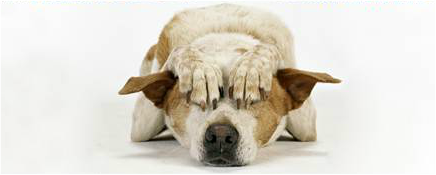by Dr Sophie Parratt
A common question I get from pet owners is ‘What do I do if my pet gets a cut or is injured? It is likely that one day your beloved friend is going to hurt themselves and in that instance to follow some basic steps will help to ensure that the wound heals well and your pet recovers properly.
Here are some tips for basic first aid and assessment.
Don’t panic- if you become distressed you are going to be of no use to you pet, take a deep breath and think! This may help them keep calm too.
1. Be careful-your pet is likely to be in pain, scared and therefore more likely to bite! You may want a muzzle when examining the wound- use a soft muzzle if you have one or a slip lead or bandage to gently tie their mouth. You may need an assistant to hold them to have a closer look.
2. Assess the wound and stop the bleeding. The principles are the same as in humans, steady pressure and elevate where possible. If bleeding is severe, apply firm pressure to the area with sterile gauze pad or a clean cloth. Do not lift the gauze or cloth to see if the bleeding has stopped- this will remove the blood clot that is forming underneath. If the wound bleeds through, apply another layer on top of the cloth/gauze already in place. Tourniquets are a last resort and must be loosened every few minutes to restore blood to the injured limb. Do not attempt to remove a protruding object from a wound!
3. Contact your vet, particularly if there is heavy bleeding, wound is large, deep or has anything imbedded in it.
4. Make sure your animal is up to date with their tetanus shots
What about more serious wounds? Pig and dog fight wounds can be far more traumatic than they look. Often animals are shaken vigorously causing injury to tissues extending much further than the wound you can see. Puncture wounds might not look like much but a tooth or tusk will have left bacteria and foreign material inside the wound. This can cause severe infection, especially if the skin closes over before the underlying tissues have has a chance to heal. It is important that these injuries are explored thoroughly, and this requires a visit to the vet.
Any further questions do no hesitate to contact us at either our Katherine or Alice Springs practices
A common question I get from pet owners is ‘What do I do if my pet gets a cut or is injured? It is likely that one day your beloved friend is going to hurt themselves and in that instance to follow some basic steps will help to ensure that the wound heals well and your pet recovers properly.
Here are some tips for basic first aid and assessment.
Don’t panic- if you become distressed you are going to be of no use to you pet, take a deep breath and think! This may help them keep calm too.
1. Be careful-your pet is likely to be in pain, scared and therefore more likely to bite! You may want a muzzle when examining the wound- use a soft muzzle if you have one or a slip lead or bandage to gently tie their mouth. You may need an assistant to hold them to have a closer look.
2. Assess the wound and stop the bleeding. The principles are the same as in humans, steady pressure and elevate where possible. If bleeding is severe, apply firm pressure to the area with sterile gauze pad or a clean cloth. Do not lift the gauze or cloth to see if the bleeding has stopped- this will remove the blood clot that is forming underneath. If the wound bleeds through, apply another layer on top of the cloth/gauze already in place. Tourniquets are a last resort and must be loosened every few minutes to restore blood to the injured limb. Do not attempt to remove a protruding object from a wound!
3. Contact your vet, particularly if there is heavy bleeding, wound is large, deep or has anything imbedded in it.
4. Make sure your animal is up to date with their tetanus shots
What about more serious wounds? Pig and dog fight wounds can be far more traumatic than they look. Often animals are shaken vigorously causing injury to tissues extending much further than the wound you can see. Puncture wounds might not look like much but a tooth or tusk will have left bacteria and foreign material inside the wound. This can cause severe infection, especially if the skin closes over before the underlying tissues have has a chance to heal. It is important that these injuries are explored thoroughly, and this requires a visit to the vet.
Any further questions do no hesitate to contact us at either our Katherine or Alice Springs practices


 RSS Feed
RSS Feed